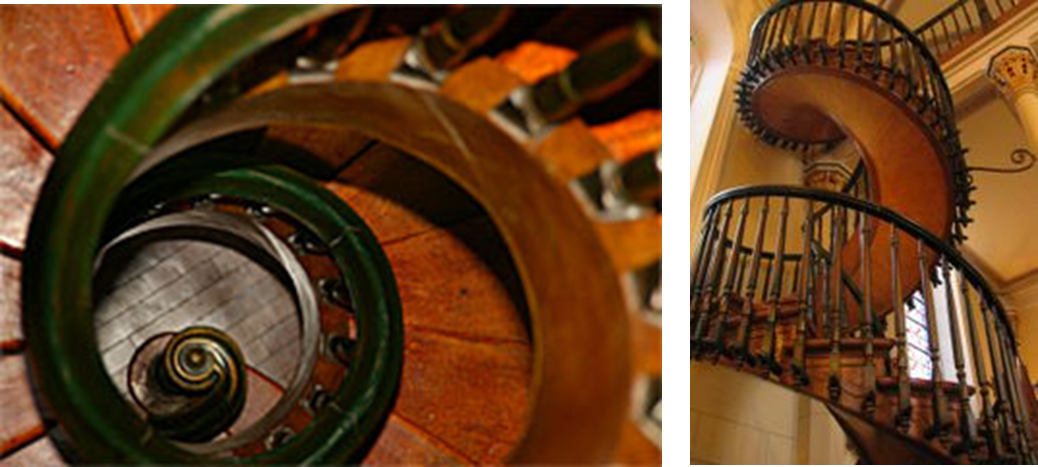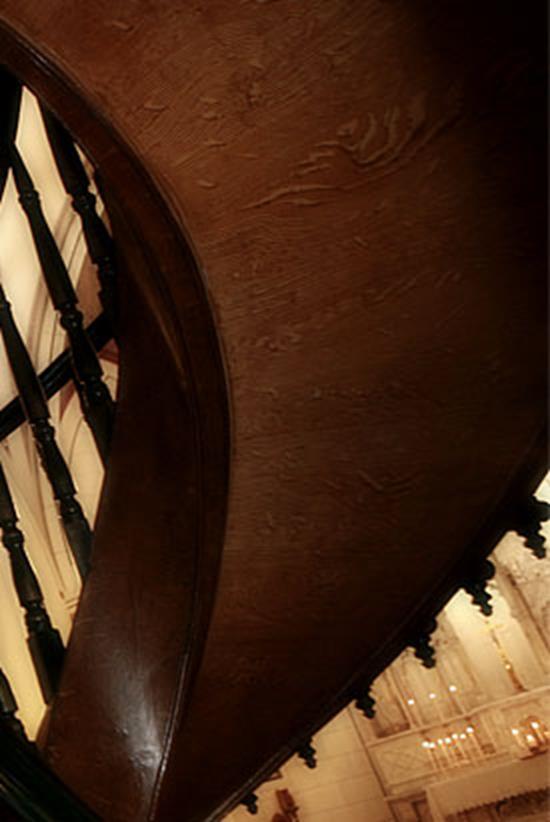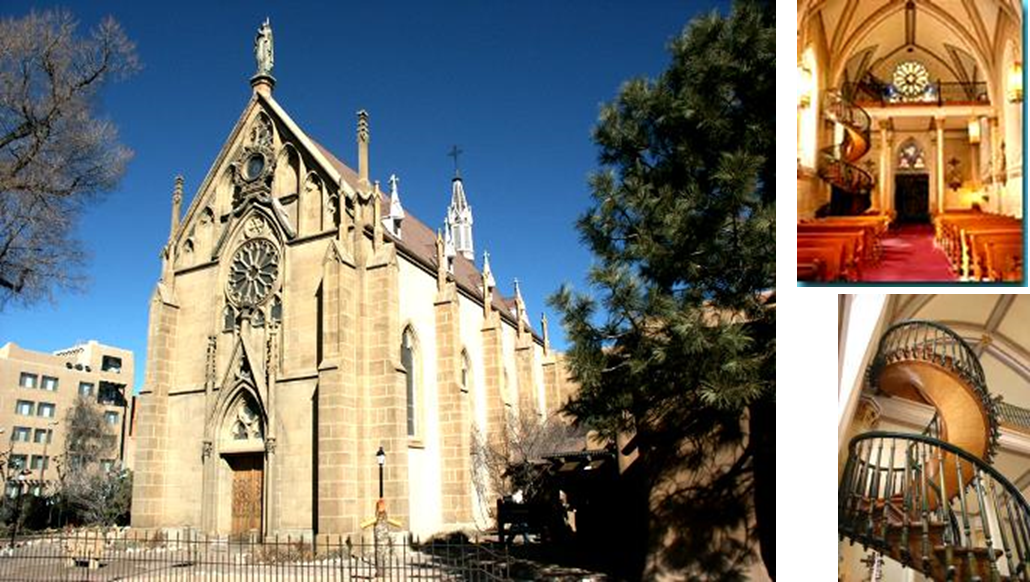
|
Labour Day 2012
Many years ago, when I was still a teenager, studied at St. Nicholas, I read a very interesting article in our Library. It was about the construction of a very special spiral staircase, it has touched my heart because the record was not only concerned about excellent construction, but very much on fatherly affection and love …
Somehow, over the years, I lost the photocopy of the aforesaid article, I have search hard for it but it was no avail. Recently, I have found the related record somewhere, I have summarized them to share with you:
ERECTED BETWEEN 1873 and 1878 on the grounds of the Academy of Our Lady of Light, a Catholic girls’ school in Santa Fe, New Mexico, United States, the Loretto Chapel stands out to this day as a rare example of Gothic Revival architecture in a landscape dominated by Pueblo and adobe.
It was commissioned by Archbishop Jean-Baptiste Lamy and designed by French architect Antoine Mouly with the help of his son, Projectus, who were said to have modelled it on the historic Sainte-Chappelle in Paris.
Since the elder Mouly was infirm and going blind at this time, actual construction of the chapel fell to Projectus, who by all accounts did a creditable job until he himself fell ill with pneumonia and died. It is here that the so-called "legend of the miraculous staircase" begins. |
|
The construction of the miraculous staircase
Despite Mouly's death, the main work on the chapel was completed in 1878. The builders were left with a quandary, however: there was no means of access to the choir loft, little or no room for a staircase, and no one had the slightest idea how Mouly had intended to address the challenge.
A conventional staircase would take up too much space in the Chapel. The Mother Superior asked many carpenters but they said it was impossible to build a suitable staircase.
Unsatisfied with the prevailing opinion that a ladder would have to suffice, the Sisters of Loretto sought divine assistance by praying a novena, asking St. Joseph, the Patron Saint of Builders & Carpenters, for his help.
On the ninth (9th) day of prayer, a kind looking stranger appeared with a donkey and a toolbox. He said he needed work, and offered to build a staircase.
Build one he did, and the glistening, all-wood structure is a marvel to behold, spiraling upward 22 feet with 33 steps from floor to loft in two complete 360-degree turns, with one end supports from the loft on top and the other end rests on the chapel floor at the bottom.
Some claimed that the Builder did the work fairly quickly, but the others said he took around 6 to 8 months to build it. |
|
According to the Sisters, the builder only used a T-Square, a saw and a hammer, they also saw pieces of wood soaking in basins. However, the local lumber yard had no record of any wood being purchased for the project.
The fact is the ingenious builder not only solved the problem of floor space, but in so doing designed a structure whose beauty actually enhanced the aesthetic appeal of the entire chapel.
When the Sisters wanted to thank and pay him, he was gone. No one even knew his name. After searching for the man (an advertisement even ran in the local newspaper) and finding no trace of him, some concluded that he was St. Joseph himself who came in answer to the Sisters' prayers.
The "miracle," then, is twofold: one, the staircase was built by a nameless stranger - possibly St. Joseph himself - who seemingly appeared in answer to a prayer and disappeared just as mysteriously; two, though built entirely of wood with wooden pegs - with no nails, no screws, no metal of any kind – and no central support as in most spiral staircases, the staircase was an innovatively built in the 19th Century and still structurally sound and stands today.
Architects, Engineers and Builders had come all over the world to inspect this work, they marveled how it was built. Some of them are especially baffled by the great precision and the curved stringers of the staircase… |
|
The wood is spliced in 7 places on the inside and 9 places on the outside, with each part forming part of a perfect curve. It has long intrigued Building Experts how this was done by one man with primitive tools in 1873.
Furthermore, the wood that the man used to build the staircase was not from New Mexico and could not be identified from any nearby source. It is still a mystery where the wood came from.
The Sisters of the Loretto Academy felt very sure that the Staircase was miraculously built in answer to their request to Saint Joseph; to ask him to help them, and many felt that the Builder was Saint Joseph himself…
The 33 steps of this spiral staircase will remind us of his foster son Jesus Christ’s 33 years among us to teach and redeem us …
This miraculous staircase is indeed a master piece of an excellent builder, who has displayed his work showing great understanding in both structural integrity, stability and precision, with the appropriate choice and treatment of the wooden material, to build the spiral staircase around 1878; that has proven to withstand the challenge of time and long usage … built using a few basic tools.
You asked me, ‘What’s your opinion?’
My Answer: The Builder of this spiral staircase is Saint Joseph. Why? I firmly believe that a piece of work produced by a person would tell who he/she really is. It would reflect his / her interior self.
When you look at this spiral staircase, don’t you feel the love and dedication of the builder; instead of using nails (which would easily rust and corrode) to hold the wooden pieces together, wooden pegs were used. Every Structural Engineer who look at it would agree with me that before such a staircase could be built, you would first need to do an exact calculation of all the dimensions to ensure that all the pieces would be able to fit beautifully to achieve 2 perfect & complete turns of 360-degrees.
He would also need to have a good understanding of the building material. Obviously, this Builder is an expert in wood, he understands what kind of wood to use and how it should be treated to ensure durability & long usage.
And most importantly, he has done a proper structural analysis and design to ensure that the staircase could be properly supported by the floor slab of the loft and the floor below, including how each step is going to provide support to the other, taking into good consideration of all possible loads including vibrational loads as the staircase is not supported at any other locations. Probably for simplicity sake, any structural engineer today would chose to use a finite element program to do such a structural analysis … and Saint Joseph had done it manually… 8-)
The staircase is not a paid work, it was left as a gift to the Sisters, and eventually for all of us to use it for free. From this wonderful work, could you not see the interior soul of the Builder? Don’t you see in his soul a well cultivated garden, bearing all kinds of fruit trees and beautiful flowers, where each of his children could find compassion and solace after a hard day’s work... This is the style of the Great Saint Joseph, a perfect model and example for all of us regardless of our professions – the quiet, diligent and clever workman, a expert in his field… Though he does not speak much, and very little record could be found about him, but his life and his work speak for itself, a man who gives his children lectures about life not in words but in DEEDS….
With the aforesaid, don’t you feel the fatherly affection of Saint Joseph? Don’t you know that he loves us and he is eager to help us when we approach him in our need? 8-)
For more details about Saint Joseph, please visit our Saint Joseph Webpage.
8-)
|


